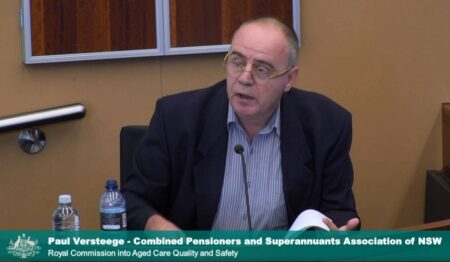ON 12 February 2019, CPSA gave evidence at the Aged Care Royal Commission, for which it had called.
Here are some of the main points canvassed during the examination.
Of all the issues that beset the aged care system the most pressing is aged care safety. Aged care safety is part of aged care quality and covers the basic or minimum components of care such adequate housing, nourishment, personal and clinical care and access to care equipment and supplies.
Another element of aged care safety is being able to get aged care. In Australia, well over 100,000 people who need aged care get an inadequate level of care or no care at all. Obviously, this is the most important safety aspect of aged care: being able to get it when you need it.
But the main objective of the Aged Care Act 1997 is the provision of funding with “due regard …to: (a) the limited resources available to support services and programs under the Act; and (b) the need to consider equity and merit in accessing those resources”.
In other words, the Act is set up to limit the supply of aged care places. Put differently, the Act is set up to not meet the most basic requirement of aged care safety and quality: adequate access for all those who need it, without exception.
Unlike Medicare and unlike the National Disability Insurance Scheme, the aged care system is not an entitlement system, but an eligibility system. ‘Eligibility’ in this context is a euphemism for ‘waiting list’. Public oral health care is also an eligibility program.
Another point made by CPSA was that recently released information shows dramatic increases in non-compliance in residential aged care. These increases were found after the Oakden nursing home scandal had broken in 2017.
It prompted assessors to start doing things differently.
Where previously they talked to residents and their families, to staff, and instead of checking nursing home records, assessors starting observing what was actually going on in nursing homes.
Suddenly they started finding non-compliance left, right and centre.
But assessors can only do spot-checks. They can’t observe all the time, unless CCTV cameras are installed to record what is going on. Assessors can then refer to CCTV footage taken at any point in time to observe.
That is not enough, though. Assessments of nursing homes should also involve medical assessments and quality-of-care indicators. To its credit the Australian Government has now announced it will introduce mandatory indicators.
However, even with the best aged care standards and ways to measure compliance with them, aged care safety won’t happen unless there is adequate staffing, both in numbers and skills. In fact, we need a separate standard for (mandatory) staff-to-residents ratios.
In 150 or so residential aged care facilities operated by the Victorian Government, mandatory staff-to-residents ratios are used. CPSA is not suggesting that the Victorian approach should necessarily be exactly replicated throughout the residential aged care system, but it does demonstrate how mandatory staffing ratios in residential aged care can be imposed without the sky falling in.
A final point covered by CPSA was split accreditation. Accreditation in residential aged care currently covers the accommodation and care functions of a residential aged care facility. This gives the provider too much leverage over regulators and care recipients.
For example, where a nursing home delivers such poor care that revoking their accreditation would be reasonable, that would mean closing down the facility and forcing residents to find a new nursing home. Obviously, the Department of Health would think twice before revoking accreditation, especially if it concerned a facility in a regional or remote area with few or no alternative facilities.
If accreditation was split between accommodation and care functions, i.e separate accreditation for the physical infrastructure and separate accreditation for care provided, the facility could be operated by two distinct entities, one operating the physical infrastructure, the other providing care. The decision to take compliance action in respect of aged care safety and quality would be easier.
Watch the video of CPSA’s evidence here, starting at 2 hours 36 minutes.
